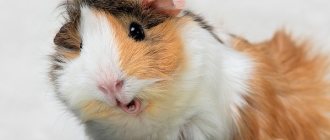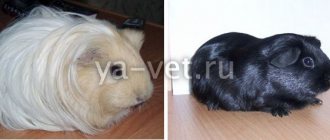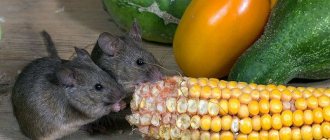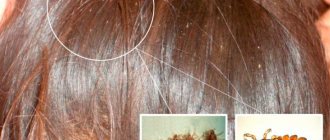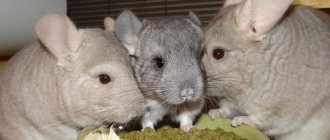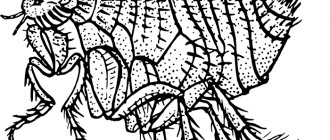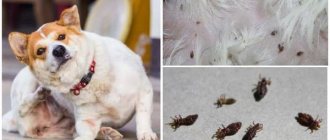The guinea pig is characterized by periodic scratching - this is how it takes care of itself. But when she is bothered by ectoparasites, she itches often and for a long time, bites her fur, trying to gnaw them out. Flea bites in guinea pigs can cause wounds, abrasions, suppuration, and allergies (due to antigen proteins contained in the saliva of insects).
Ectoparasites carry infectious diseases, eggs and larvae of helminths. In order not to endanger the health of the pig, its owner must know how to identify and remove them in a timely manner.
If your pig begins to chew out its fur before sores appear on its skin, then the animal may have fleas.
Carrying out diagnostics
You can identify fleas yourself. They can be seen with the naked eye on the rodent's face and stomach. If you comb the fur with a single-row, fine-toothed comb, it will leave behind insect excrement in the form of small brown clumps, as well as dead or living insects. Parasites are easier to detect on animals with light fur.
If the diagnosis is carried out by a veterinarian, he takes a scraping from the rodent's skin for examination.
A pig can have several diseases at the same time, for example:
- allergic dermatosis;
- ectoparasites;
- streptococcal infection;
- neurodermatitis;
- mycoses.
Any of these factors, as well as metabolic disorders and poor nutrition, cause itching, sore skin and hair loss.
To determine the presence of the disease, a scraping is taken from the animal's skin.
lice eaters
This is another type of parasite that differs in that it can feed not only on particles of the animal’s skin, but also on its blood. Due to the small size of the parasites, it is quite difficult to detect them with the naked eye; you will have to use scraping. The first signs include hair loss of the animal, as well as itching. An animal's reduced appetite threatens death from exhaustion. The danger is that lice can get on the animal even with careful care, for example, through the owner’s clothes or toys from the store.
Comprehensive treatment measures include treating all animals that have previously been in contact with or are close to an infected individual, even if they do not show signs of infection.
Akaromectin, Bolfo and Bars spray can be used as medical assistants in the fight against lice eaters. Due to the fact that bathing is considered extremely stressful for pigs, it is best to opt for a spray, as it will cause them less discomfort. The animal does not resist the procedure and, if necessary, it must be repeated the prescribed number of times. This is usually done by a veterinarian. Lice remedies are also available in human pharmacies, but you need to choose those options that contain the substance permethrin. The largest number of breeders recommend choosing Advocate spray. Due to the content of fewer toxic substances, it is safer for the animal.
Lice eaters are localized in the croup and perineum; they parasitize at the roots of the hair, wrapping their limbs around the hair, and feed on blood, epidermal scales and secretions of the sebaceous glands. As a result, the affected hair falls out. Lice eaters are most active in winter, when the guinea pig's fur becomes thicker and longer, which is a favorable factor for the proliferation of parasites.
Lice feed on blood and are able to actively move around the animal’s body, causing itching. Parasites can be seen with the naked eye when parting the fur, mainly in the head area and around the ears.
Guinea pigs become infected with lice and lice through contact with sick relatives, through bedding and food.
Lice and lice cause itchy skin and severe anxiety in a sick animal, up to the appearance of seizures and convulsions. Fleas with intense infestation can cause inflammation of the skin - flea dermatitis. It is characterized by redness of the skin, baldness, and eczema.
What symptoms indicate the presence of fleas
Signs that an animal is being bitten by fleas are as follows:
- redness and peeling of the skin, bite marks (usually on the stomach) in the form of red dots;
- the pig behaves restlessly, shakes its head, itches, eats poorly, becomes less active;
- In places where insects accumulate, hair loss may occur.
Insects pierce the skin and drink blood. The bites are painful, and there are no anesthetics in the saliva. In the affected areas, the skin becomes inflamed, itches, and hurts when scratched.
Flea bites cause red spots on your pig's skin.
Ticks
Perhaps it’s not fleas that have clung to your pet, but scabies or fur mites. Do pigs have ticks? Such cases are observed. Don't worry, with proper treatment, the parasite is easy to get rid of. To avoid confusing your guinea pig's fleas with a tick, examine your pet. If it is a scabies mite, you will notice the following symptoms:
- skin itching;
- rough areas on the skin;
- areas with lost hair.
However, the tick itself cannot be detected: its size is too small.
The fur mite has similar symptoms: the pig itches, its fur becomes coarser, becomes sparse, and dandruff appears.
The veterinarian will definitely examine the hairs and skin particles under a microscope. Treatment in both cases is identical: most likely, it will be drugs based on ivermectin. They are prescribed courses. The animal's fur is processed several times.
Do you have other pigs who have had direct contact with the sick pet? If yes, then treatment should be carried out for everyone. At least carry out a one-time treatment of animals as a preventive measure. In addition, the cell should be treated with sulfuric lime. Make sure your pigs don't swallow any medications! This is dangerous to your health.
What other parasites can pigs get?
Several types of parasites can appear on pigs:
- Ticks. Sources of infection are other animals, human skin and clothing, and poorly washed food. First, mites infest the skin of the head, back and sides, then the entire body. Depending on the species, they settle on the surface of the skin or in the depths, eating away passages in the tissues. Causes severe itching. The animal injures itself with constant scratching, experiences stress, and reaches exhaustion. A pregnant female may have a miscarriage.
- Lice. Insects are yellowish in color, smaller than fleas. Infection occurs through contact with other animals or through bedding. Lice bite into the skin and feed on substances that are released. This causes itching, redness, crusts and papules. With severe infestation, the fur around the ears and lower abdomen becomes dull. Parasites lay white eggs called nits on hairs. Lice living on guinea pigs are species specific. They cannot be transmitted to humans.
- Vlaseaters. These are yellowish-gray worms up to 1 mm long. They hold tightly to the animal’s body with the help of 3 pairs of legs and multiply quickly: 1 female lays about 70 eggs (nits) at a time. They feed on epidermal particles and fur, contaminating the skin and chewing hairs. Causes skin irritation, dermatitis and baldness. Sources of infection are sick pigs, sawdust, and unsealed food. Lice eaters are not dangerous to people.
Ticks can be detected by laboratory testing of skin scrapings or on litter. They look like small dots (hungry insects are gray, and those that have drunk blood are red-brown).
Lice and lice can bring a lot of unpleasant moments to your pets.
Do they exist?
Guinea pigs do have fleas, and quite often. The most common type is the so-called cat flea. In addition to cats, this parasitic insect can infect dogs, hedgehogs and rodents. Pets pick up an infection on the street, bring it into their homes, become a source of parasites for other animals, and begin to get sick themselves.
Fleas are blood-sucking insects. To feed, they bite the unfortunate animal, as a result of which the latter develops severe itching of the skin. Overcome by fleas or other ectoparasites, the pig is constantly itching and scratching itself. As a result, wounds and abrasions form on the pet’s body, which then develop into dermatitis and other skin diseases. In addition, the animal develops anemia.
Methods for removing parasites
For treatment use:
- Shampoo. When bathing, apply to wet fur and rub over the entire body so that it does not get into the eyes and ears. The product must be rinsed off well. When it enters the body, the digestion of animals is disrupted. You need to wash the cage and the area near it with the same shampoo, and change the bedding. The procedure is repeated after 10 days to destroy the larvae. When choosing this method of treatment, one must take into account that pigs are afraid of water and experience stress when bathing.
- Spray. The jet is directed onto the skin against hair growth. Most drugs have an unpleasant odor, so it is better to carry out treatment on the balcony or on the street. The pig should be held in your hands until the spray dries to prevent it from licking the medicine.
- Drops. The dose is drawn into a syringe, the needle is removed, the fur is pulled apart and dripped onto the skin, but not onto the wounds. You need to hold the animal in your hands for about 10-15 minutes until the product is completely absorbed.
- Injections. Subcutaneously into the withers.
Basic rules of treatment:
- at the same time it is necessary to process the hair of all domestic animals;
- every 3 days, disinfect cages and bedding (they must always be dry);
- You cannot use several different drugs at the same time;
- the preparations Neostamazan, Ethnomazan, Stomazan, Butox are not used for pigs (they can only treat surfaces - cages, bedding and other equipment).
The cage must be cleaned every three days.
Used against fleas:
- drops – Advocate, Blokhnet, Stronghold, which can be combined with anti-inflammatory and antimicrobial drugs;
- shampoo “Nizoral” and others containing pyrethritol;
- sprays – 8 in 1, Frontline, Bolfo.
Do not exceed the dose - this can lead to poisoning of the pig. It is better to buy special preparations for rodents. When using medications intended for kittens, take 0.1 ml of Advocate or 6 ml of Stronghold per 1 kg of pig's weight.
Use flea drops in conjunction with antimicrobial drugs.
The above sprays and drops are used against ticks in the same way, as well as injection preparations:
- Ivermectin. Per kg of weight, 0.02 ml of the drug is combined with 0.2 ml of saline solution. The product is considered difficult to use, since it is difficult to calculate the dose and measure it, and exceeding it is dangerous for the pig’s brain.
- Otodectin (variation with 0.1% ivermectin) at the rate of 0.2 ml/kg.
Injections are given once every 10 days, 2-4 injections in total (depending on the degree of damage). Ivermectin is applied to inflamed areas of the skin 2-3 times a day. The cage needs to be washed with a solution containing chlorine and the bedding changed.
The results of scraping tests are positive in only 45-50% of diseases, so the same treatment can be prescribed in case of suspected mite infection with negative results of scrapings. The effect is observed within 3-4 weeks.
Often a tick infection is complicated by the appearance of a fungus. It primarily affects the scalp, neck and extremities. It is treated with Chlorhexidine, Lamizine, etc.
We make injections into the animal's withers.
Help against lice and lice:
- sprays Bars, Celandine, Bolfo, Dana, Akaramectin;
- Ivermectin injections (if there are a lot of parasites);
- Advantix drops, Frontline, Advocate.
If nits are present, the treatment is repeated after 2 weeks. Insecticides kill only adult insects.
The least toxic are pyrethrin-based preparations, such as 8 in 1 sprays and Beaphar. They can be used to treat pregnant and lactating females and cubs weighing up to 500 g.
Sprays against lice and fleas destroy only adult individuals, but not nits.
[vote2x id=”2300" align=”center”]
Prevention
If in addition to the guinea pig, there are other pets in the house - cats or dogs, they must be regularly treated with insecticides so that they do not catch the infection and “reward” the little pet with it. This rule especially applies to those pets who are allowed to go outside for a walk.
The usual requirements for the conditions of keeping a pig play the role of preventive measures. These include:
- cleaning the animal's house;
- changing filler and bedding;
- treating the pet's cage and items with disinfectants.
All this should be done regularly and on an ongoing basis, and not just during or after an illness. Before going on walks, your pig needs to be protected against parasites.
It is very important to seek medical help at the first symptoms of infection. The consequences of an advanced disease are irreversible for the animal’s body, which leads to its death. The sooner treatment is started, the greater the chances of ridding your pet of the disease and returning him to his normal life and normal well-being. It is not worth treating the animal on your own - only a veterinarian can prescribe the correct treatment. Self-selected therapy can cost the animal its life. Control by a veterinarian and a responsible approach to healing your pet are the key conditions that will soon allow you to see your pet healthy and active.
Preventive actions
To prevent infection with ectoparasites, pigs need proper care and maintenance, the nature and characteristics of which are as follows:
- periodic examination of all pets;
- treating all items they use with insecticides;
- disinfection of feed purchased in bulk (it is kept in the freezer for 1 day);
- maintaining personal hygiene before interacting with a rodent.
Pets that are taken for walks should wear tick collars in the spring and summer. During this period, parasites are especially active. Some of them are carriers of the meningoencephalitis virus, which is dangerous for animals and people.
The weakened immunity of the pig can become the basis for the appearance of subcutaneous mites and fungal diseases. An unhealthy animal with poor appetite becomes depleted quickly when attacked by parasites.
To improve health, vitamin complexes (C, B1, B2, A, E, folic acid), drugs with anti-inflammatory, antitoxic and immunostimulating effects are prescribed - Sporovit, Katozal, Gamavit, etc.
If your pig develops itching and anxiety, it is best to contact a veterinarian or rodentologist (a specialist in small exotic mammals) and undergo treatment under medical supervision.
Optimal Treatment Methods
First of all, you need to clean the animal's cage. The litter will have to be thrown away. The remaining parts of the animal’s home are thoroughly washed and disinfected.
If ticks appear, it is important to contact a specialist promptly. If the animal’s skin peels, you must first wash it with special shampoos - “Lactoderm” or “Doctor”. Next, all crusts and thickenings are removed. Then either a spray or cream is applied.
When infested with lice or fleas, the following medications are used:
- spray "Frontline";
- spray "Flea&Tick";
- Beaphar spray;
- spray company 8 in 1;
- Ultracare spray.
Repeated treatment is carried out after 8 days. Information on dosage and usage details can be found in the instructions on the package.
An infected animal must be treated daily with a spray or powder. It is important to ensure that the substance does not enter the pig’s mouth or eyes.
You can also learn about home and traditional methods for controlling fleas in dogs.
Guinea pigs experience itchy skin quite often. As a rule, this is a signal that parasites have appeared on the animal’s skin.
Worms
Due to the fact that the main property of this group of parasites is to absorb nutrients from the animal’s blood, this can lead to exhaustion. Typically, guinea pigs are inhabited by tape and round parasites. Worm larvae of this type are dangerous not only for the animal, but also for the owner. With severe infection, you can see not only worm larvae in the stool, but also quite adult individuals with the naked eye. The animal is characterized by lethargic behavior, drowsiness and decreased appetite. If the infection is very strong, parasites crawling out of the anus can also be seen with the naked eye.
If the infection is not severe, you can give the animal a suspension of prazicide for kittens. The amount is calculated at the rate of 1 gram per 1 kg of animal weight. Dirofen paste has a good reputation among veterinarians. When treating an animal with medications, you need to treat the cage and accessories with a chlorine-containing solution.
Fungal, viral and oncological diseases
“Pigs” also suffer from fungal, viral and oncological diseases. All of them can be the root cause of pathologies of the kidneys, liver, heart and other systems mentioned above.
Tumors
In most cases, tumors develop in older pets. Their diversity is extremely large, but all neoplasms can be divided into two large types: benign and malignant. The following benign neoplasms are encountered in veterinary practice:
- Lipomas (from adipose tissue).
- Myomas (from muscle tissue).
- Adenomas (develop in the glands).
- In addition, fibroids are quite common in pigs (they grow from connective tissue).
As a rule, benign tumors do not manifest themselves in any way throughout the life of the mumps. The types of malignant tumors are no less diverse, but they are much more dangerous for the health and life of the pet:
- Carcinomas. Develop from epithelial tissue.
- Melanomas. Any mole on a pig’s body can “mutate” into something extremely dangerous.
- Sarcomas. They grow from connective tissue.
Other types of tumors in pigs are not very common. The clinical picture is as follows:
- As a rule, the animal becomes lethargic and quickly weakens.
- At first, appetite increases sharply, but as the disease progresses, it steadily worsens.
- Other symptoms directly depend on which organ the tumor has grown in. In particular, with liver damage the symptoms are the same, with kidney pathology the symptoms are different.
Fungal diseases
Fungal diseases are deservedly considered one of the most serious. They are very difficult to diagnose, but even more difficult to treat. The following ailments are detected in pigs:
- Ringworm (i.e. microsporia and trichophytosis).
- Weeping eczema (aka weeping lichen).
- Cheilitis mentioned above.
- Pityriasis versicolor.
- Deprive Zhiber.
- Lichen planus.
The variety of fungal pathologies is quite large. The following symptoms may indicate their development:
- Strange sores suddenly appear on your pet's skin. With many types of lichen, they have rounded outlines.
- Hair loss is very common. In many cases, the hairs do not fall out, but break off near the very root, which is why bristly areas dotted with “stumps” from broken hairs remain on the animal’s skin.
- The skin in these areas may become red, inflamed, scaly, and flaky.
- In many cases, the animal experiences severe and never-ending itching. The animal is worried, runs around the cage, rubs against all nearby surfaces.
- Many types of lichens are characterized by the development of pyoderma. In these cases, the skin is dotted with many pustules.
- If the case is advanced, the pig weakens, refuses food, and due to the “shrunken” immunity, the development of other infections is possible. First of all, the respiratory organs are affected, and therefore the animal begins to cough, sneeze, and breathing becomes hoarse.
Viral diseases
These animals also have viral diseases:
- Plague.
- Lymphocytic choriomeningitis.
- Viral sore throats.
The symptoms are as follows:
- The animal develops mucous or purulent discharge from the nasal passages.
- Breathing is heavy, labored.
- A strong, choking cough is possible.
- The animals' body temperature rises sharply.
- In some cases, convulsions and seizures resembling epileptic seizures are observed.
- Sometimes sick pigs lose their hind legs; in very rare cases, complete paralysis of the body is possible.
- In severe cases of the disease, the pet completely or partially refuses food, but thirst remains and even intensifies.
The most common diseases of guinea pigs
Diseases of pigs can be divided into 5 groups:
- The first group is diseases caused by improper nutrition and maintenance. The most common health problems.
- Genetic defects. They are registered in cases where males and females who are carriers of the “defective” gene mate. Often these “defective” pigs are sold at poultry markets, since sellers do not monitor the cleanliness of the line, striving only for profit.
- Infectious diseases (bacteria, viruses, fungi). Fortunately, infectious diseases in guinea pigs are not recorded very often, since they are rarely taken outside and have no contact with other animals. However, you should not relax and assume that since your pet sits in a cage for days, then it will not get sick with anything contagious or dangerous.
- Parasitic diseases. Both skin and intestinal parasites can cause a guinea pig to not eat anything, become sad, lethargic, and thin. The appearance of the animal is not pleasing to the eye.
- Injuries. Rodents are small, fragile, and have thin bones, so rough and careless handling of them can lead to serious injury. For example, if you leave a pig running around on the floor, you might accidentally step on it. Or a child will take the rodent in his arms and want to cuddle it, as a result of which he may inadvertently break bones, severely squeeze internal organs, or even drop it to the floor.
- Most often, eye diseases are recorded in rodents. This includes conjunctivitis and cataracts (often diabetic). In pigs, a bone formation called a limbus often appears on the outer surface of the eye.
- Another disease that is recorded in overseas rodents is pseudotuberculosis (a disease of bacterial etiology). With it, nodules form on the affected organs/tissues. With pseudotuberculosis, the animal has loss of appetite (followed by exhaustion), diarrhea, even paralysis. Treatment of the animal should take place exclusively in a hospital, but not at home!
- Sometimes paratyphoid fever is registered in pigs, during which the pet’s appetite disappears (the animal does not eat anything), the fur becomes ruffled, the eyes become dull, diarrhea and lethargy appear. As soon as the owner notices such symptoms, he should immediately ensure that the animal is examined by a veterinarian. The doctor will select treatment, prescribe antibiotics, as well as a drug that will destroy the causative agent of the disease (so-called bacteriophages).
- If the animal’s fur near its nostrils becomes wet, coughing and sneezing appears, the baby rubs its nose with its paws, breathes wheezingly and heavily, then it may be pasteurellosis (humans can also have this disease). What to do in this case? Contact a veterinarian immediately (alas, the animal will have to be euthanized, because treatment almost always fails)!
- Not only the respiratory system suffers in a guinea pig, but the digestive system often “fails.” It’s one thing if the problem is improper feeding, in this case it will be enough to change the diet. But diarrhea, vomiting and loss of appetite (the pig doesn’t eat anything, even the most favorite treats) are associated with much more serious illnesses (for example, infectious diseases).
- Rickets is registered in dogs, guinea pigs, and humans. With a lack of calcium and vitamin D in the diet, the bones become soft, brittle, easily bent and broken. And if you feed the rodent incorrectly, do not give it vitamin supplements, and keep it in a dark corner, then the rodent will get sick very quickly.
We suggest you read: How to treat fungus with vinegar essence
